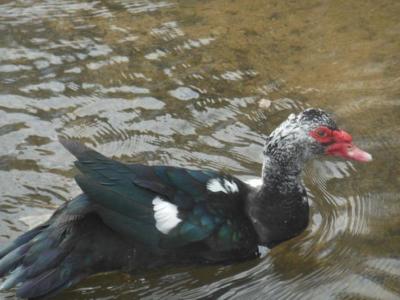 SKC Films Library SKC Films Library |
| |
| SKC Films Library >> Science >> Zoology >> Birds >> Order Anseriformes |
| Muscovy Duck Cairina moschata Description This large duck is 26-33 inches long, weighs 2-9 pounds, and has a wingspan of 54-60 inches; females are noticeably smaller than males, and domesticed muscovies are larger than wild muscovies. Truly wild muscovies are dark green, almost black, with large white wing patches and lead blue legs. The male has a prominent blackish or dark red knob at the bill base, a bare skin face that is similar to the knob in color, and a mane-like crest. The female's plumage is very similar to the male's, but her knob and crest are far less prominent and her face is feathered. The juvenile is duller overall, with little or no white on the upperwing. Domesticated muscovies come in a wide range of colors and color patterns, but the most common patterns are mostly black with some white and mostly white with black markings. Distribution and Habitat The muscovy is native to tropical America from Mexico to Peru and Argentina, but has been introduced to and domesticated in many parts of the world. Truly wild muscovies are found on streams, lakes, and marshes that are surrounded by woods and forests, while domesticated and feral muscovies occupy a wide variety of habitats, including cold climates. Reproduction During the breeding season (August to May), dominant male ducks attract female ducks by wagging their tails and showing off their crests. In most flocks (wild and domestic), a few males mate with most of the females. Unsuccessful males form small bachelor groups. After a female mates she builds a nest in a hollow tree, anywhere from 9 to 60 feet above the ground. Nests are constructed of twigs, stems and mud. Eight to ten white eggs are laid per clutch, and are incubated solely by the female for 33-35 days. The hatchlings are protected by the female for 60-70 days, at which time they are able to fly and care for themselves. Although the male does not participate in the rearing of ducklings, he will zealously guard the area around his mates' nesting sites. Both sexes reach sexual maturity at about 28 weeks, and they can live up to 8 years in the wild. Diet Muscovies feed on the roots, stems, leaves, and seeds of aquatic and terrestrial plants, as well as small fish, reptiles, crustaceans, insects, millipedes, and termites. Muscovy ducks dabble and graze with their bills to collect food. Other Habits and Behaviors In the wild muscovies roost and nest in trees. Outside of the breeding season they live in flocks of 50 or more. Muscovies have very different vocalizations from other ducks. Males have a dry hissing call, while females make quiet trilling "pip" sounds. Neither sex "quacks." Scientific Classification phylum Chordata SOURCES |
| SKC Films Library
>> Science
>> Zoology >> Birds >> Order Anseriformes This page was last updated on April 16, 2017. |
